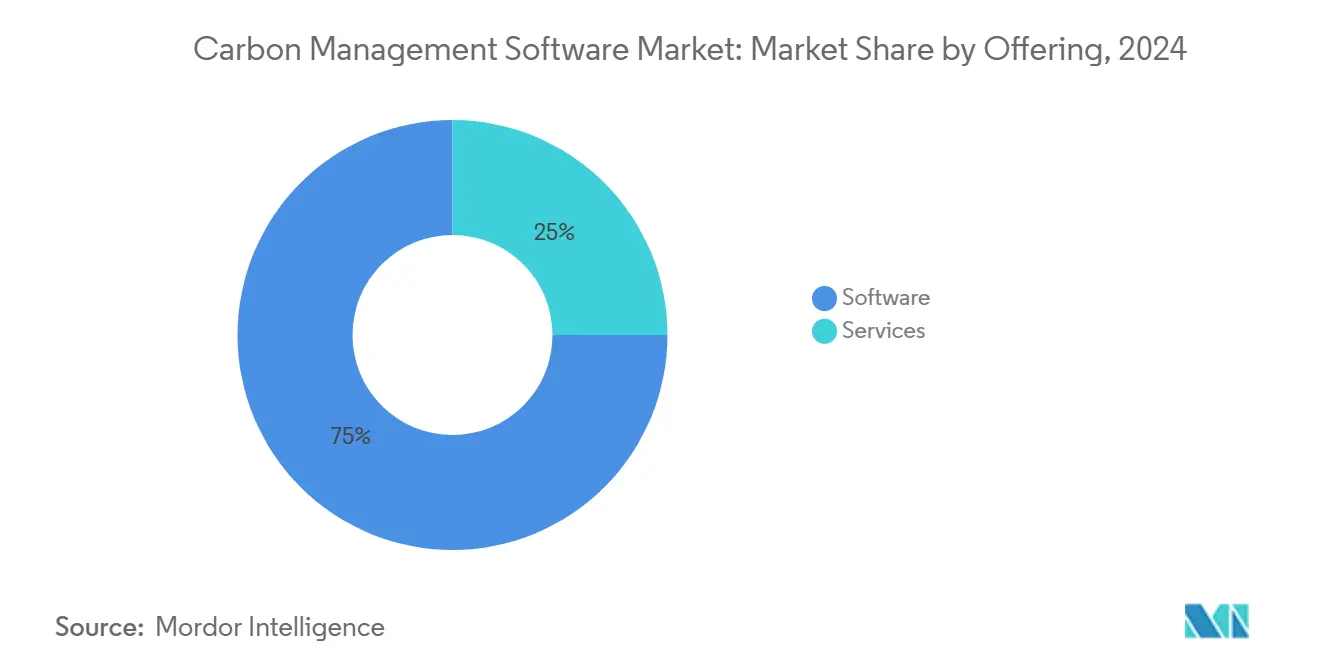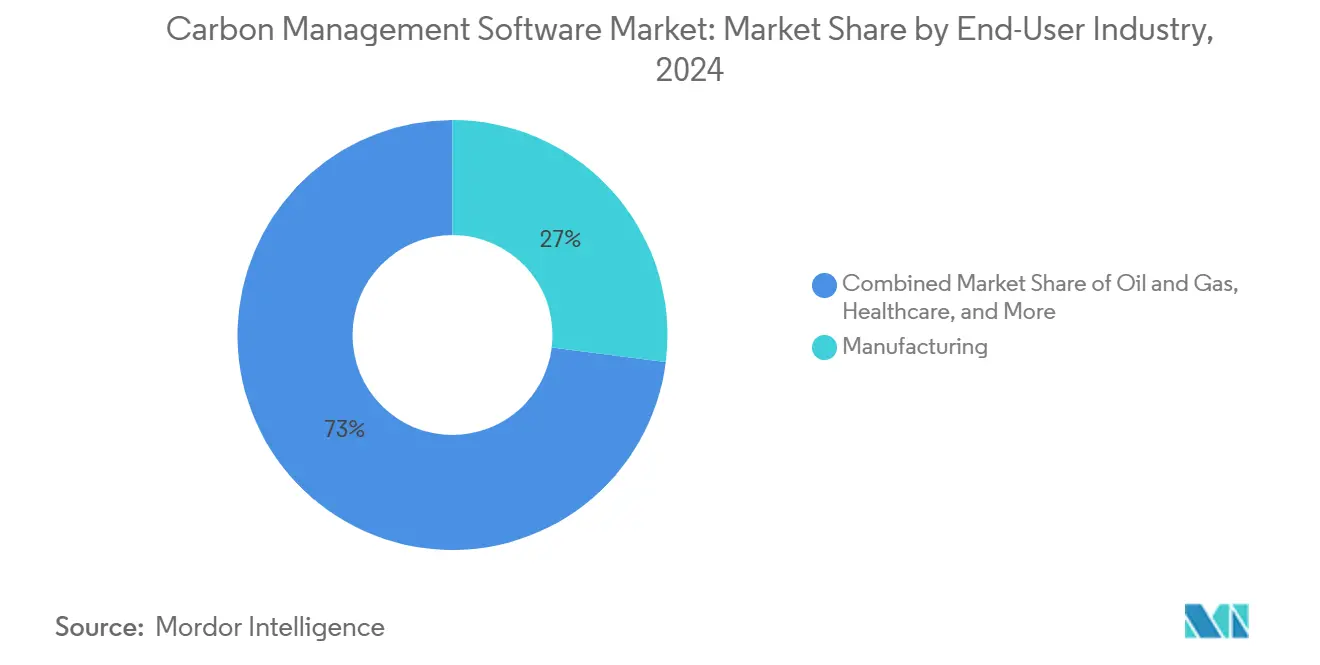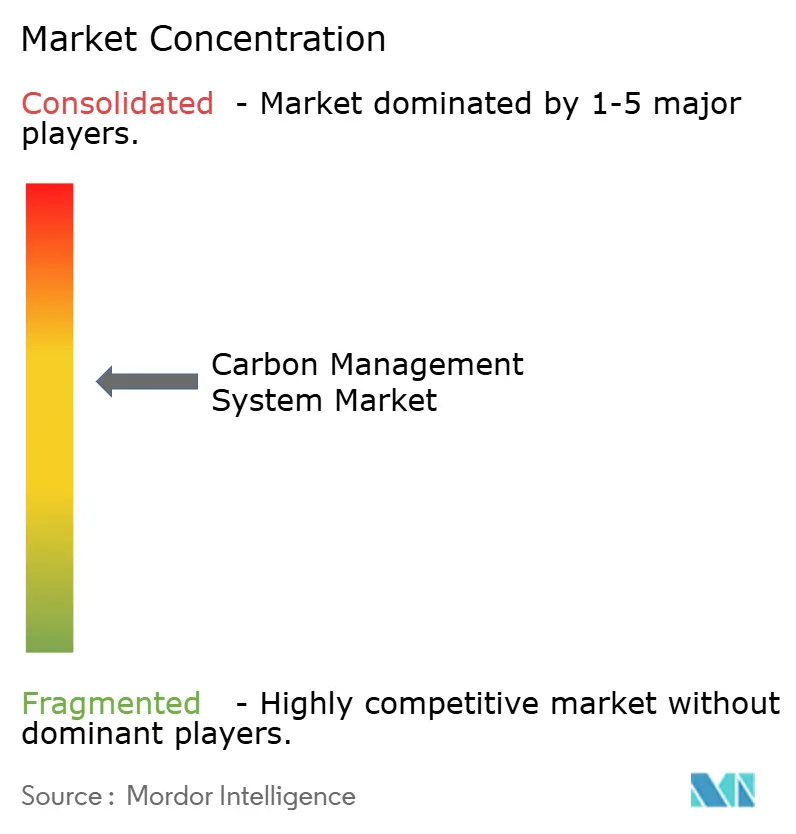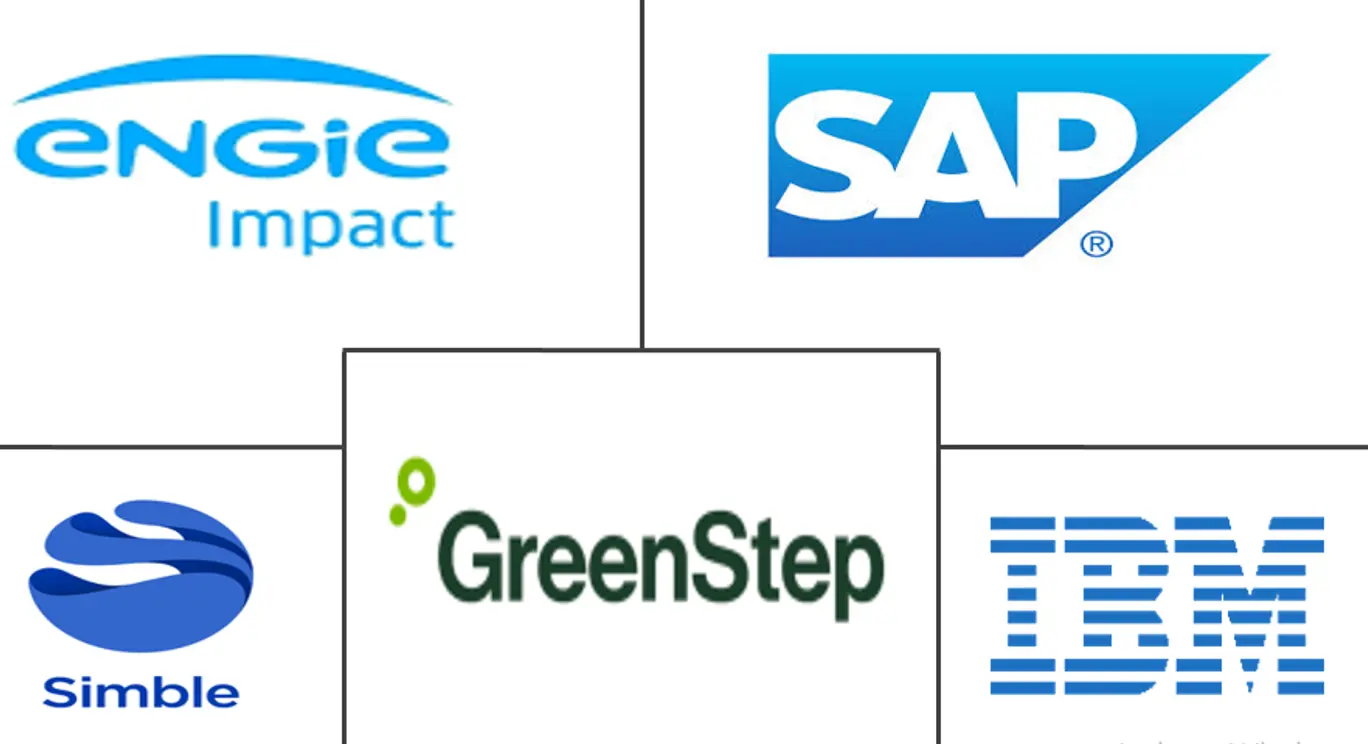Carbon Management Software Market Size and Share

Carbon Management Software Market Analysis by Mordor Intelligence
The carbon management software market size is valued at USD 16.11 billion in 2025 and is forecast to reach USD 32.50 billion by 2030, expanding at a 15.07% CAGR. This trajectory reflects the strategic convergence of regulatory mandates, enterprise net-zero commitments, and rapid advances in AI-enabled data analytics that are transforming emissions tracking from a discretionary activity into a core business function. Heightened scrutiny from the SEC climate-risk rules in the United States and the Corporate Sustainability Reporting Directive in the European Union is compelling companies to adopt audit-grade carbon accounting platforms that integrate directly with ERP, procurement, and energy-management systems. Large corporates remain the principal buyers, yet adoption is accelerating among small and medium enterprises thanks to simplified SaaS offerings and green-finance incentives. Cloud deployment dominates because it delivers the scalability and interoperability needed to ingest granular Scope 3 data from suppliers in real time. Competitive intensity is rising as established software vendors embed carbon modules into existing product suites while specialists differentiate through sector-specific analytics and tokenized-credit capabilities. Near-term market opportunity is underpinned by the fact that only 10% of companies presently measure greenhouse-gas emissions comprehensively, creating a sizeable technology-replacement cycle.[1]SEC, “SEC Adopts Rules to Enhance and Standardize Climate-Related Disclosures,” United States Securities and Exchange Commission, sec.gov
Key Report Takeaways
- By offering, software held 75% of the carbon management software market share in 2024, while services are projected to grow at a 15.2% CAGR through 2030.
- By deployment mode, cloud solutions accounted for 68% revenue share of the carbon management software market size in 2024 and are expanding at a 16.4% CAGR.
- By end-user industry, manufacturing led with 27% of the carbon management software market share in 2024; transportation and logistics is forecast to register the fastest 15.3% CAGR to 2030.
- By organisation size, large enterprises represented 61.3% of 2024 revenue, whereas SMEs are set to advance at a 16.8% CAGR over the forecast period.
- By geography, North America commanded 41% of 2024 revenues, while APAC is poised to see the quickest 16.9% CAGR through 2030.
Global Carbon Management Software Market Trends and Insights
Drivers Impact Analysis
| Driver | (~) % Impact on CAGR Forecast | Geographic Relevance | Impact Timeline |
|---|---|---|---|
| Stricter carbon-disclosure regulations | +4.2% | EU and North America | Medium term (2-4 years) |
| Corporate net-zero commitments | +3.8% | Developed markets | Long term (≥ 4 years) |
| Cost savings from energy-efficiency projects | +2.9% | Global | Short term (≤ 2 years) |
| AI-driven Scope 3 data harmonisation | +2.1% | North America and EU | Medium term (2-4 years) |
| Tokenized carbon-credit integration into EMS platforms | +2.4% | EU, US, Singapore, APAC early adopters | Medium term (2–4 years) |
| Source: Mordor Intelligence | |||
Stricter Carbon-Disclosure Regulations Drive Systematic Adoption
The 2024 SEC climate-risk rules oblige public companies to disclose Scope 1 and 2 emissions in filings, creating a de facto compliance requirement for audit-ready carbon accounting systems. Simultaneously, the EU CSRD will compel roughly 50,000 companies to begin reporting Scope 3 data in 2025, with significant fines for non-compliance. Australia, Japan, and Canada are introducing analogous frameworks that extend obligations down the supply chain, prompting proactive investments in carbon-management technology even among suppliers that are not directly regulated. Collectively, these regulations remove any residual ambiguity over whether emissions data must be captured to financial-statement standards and transform the carbon management Software market into a mandatory software category.
Corporate Net-Zero Commitments Accelerate Platform Integration
More than 1,000 multinationals have adopted science-based targets that require year-on-year progress toward 1.5 °C pathways.[2]Science Based Targets Initiative, “Companies Taking Action,” Science Based Targets Initiative, sciencebasedtargets.orgCardinal Health, for example, cut Scope 1 and 2 emissions 17% by fiscal 2024 after integrating carbon software with its enterprise data warehouse. Similar commitments by Novo Nordisk and GE HealthCare illustrate how emissions platforms are linked directly to procurement, logistics, and R&D planning to inform strategic decarbonisation roadmaps. These enterprise-wide programmes reinforce demand for solutions that can connect operational and financial data, support scenario modelling, and generate investor-grade disclosures.
Cost Savings From Energy-Efficiency and Cloud Migration
Industrial clients are achieving double-digit reductions in energy spend by pairing IoT sensors with machine-learning analytics that flag HVAC inefficiencies and production bottlenecks. The shift from on-premise to cloud deployment further lowers total cost of ownership by removing the need for local servers while enabling continuous software updates. The resulting operational savings help offset licence and implementation fees, accelerating deal conversion among cost-sensitive buyers.
AI-Driven Scope 3 Data Harmonisation Unlocks ESG Finance
AI and natural-language processing streamline the aggregation of supplier-level invoices, bills of lading, and utility records, enabling near-real-time calculation of Scope 3 emissions. Enhanced data integrity supports the issuance of sustainability-linked loans that reward verified decarbonisation, opening new capital-market channels for companies that can document progress. The Department of Energy’s USD 3.1 billion programme to deploy regional Direct Air Capture hubs underscores the link between granular data, public funding, and emerging carbon-credit marketplaces.[3]Department of Energy, “DOE Announces $3.1 Billion for Carbon Management Technologies,” US Department of Energy, energy.gov
Restraints Impact Analysis
| Restraint | (~) % Impact on CAGR Forecast | Geographic Relevance | Impact Timeline |
|---|---|---|---|
| High implementation and integration costs for SMEs | -2.3% | Developing markets | Short term (≤ 2 years) |
| Data-accuracy and standardisation gaps | -1.8% | Multinational operations | Medium term (2-4 years) |
| Vendor lock-in risk from proprietary emission factors | –1.6% | Global (enterprise EMS buyers) | Medium term (2–4 years) |
| Cyber-security liabilities in audit-grade data trails | –2.1% | North America, EU, APAC industrial sectors | Medium–Long term (3–5 years) |
| Source: Mordor Intelligence | |||
High Implementation Costs Create SME Adoption Barriers
Typical licence fees for enterprise-grade carbon software range from the low-five to mid-six figures annually, placing them out of reach for many SMEs. Limited in-house expertise and fragmented data further elevate consulting costs. Green-finance instruments can defray expenses, yet uptake remains modest in emerging markets where credit access is constrained. Vendors are responding with modular, pay-as-you-grow offerings, but the near-term growth of the carbon management software market among smaller firms will remain sensitive to price.
Data Standardisation Challenges Impede Cross-Platform Integration
Global corporations rely on different emission-factor databases maintained by agencies such as the US EPA and the UK BEIS. Variations in methodology can yield materially different footprint calculations for identical activities, complicating assurance and undermining investor confidence. Blockchain pilots, including Oxy’s ledger-based verification for its direct-air-capture facility, show promise for immutable audit trails, yet industry-wide adoption is still at an early stage.
Segment Analysis
By Offering: Software Dominance Meets Services Growth
Software accounted for 75% of 2024 revenue as enterprises sought end-to-end platforms that combine data ingestion, carbon accounting, and predictive analytics in a single interface. The carbon management software market size attributed to software is forecast to rise from USD 12.1 billion in 2025 to USD 23.9 billion by 2030. Continuous emissions monitoring and real-time dashboards enable management teams to link abatement actions directly to financial outcomes, reinforcing the software’s strategic importance.
Services revenue is increasing at a 15.2% CAGR as organisations grapple with Scope 3 data-collection complexity and regulatory mapping. Advisory firms embed industry-specific factors and design change-management programmes that accelerate user adoption. Over the forecast period, integrated software-plus-services bundles are expected to represent the dominant procurement model within the carbon management software market.

Note: Segment shares of all individual segments available upon report purchase
By Deployment Mode: Cloud Transformation Accelerates
Cloud solutions captured 68% of 2024 spending, reflecting IT-budget preference for OpEx-based subscriptions and the need for near-infinite scalability to process granular supply-chain data. The carbon management software market share for cloud is forecast to reach 74% by 2030, supported by hyperscaler partnerships that provide secure, regionally compliant data-residency options.
On-premise platforms persist among highly regulated sectors, including defence and utilities, where data-sovereignty rules prevail. Hybrid architectures are gaining traction, allowing sensitive data to remain behind the firewall while leveraging cloud analytics for global reporting. Vendors are investing heavily in zero-trust architectures to counter rising cyber-risk associated with ESG disclosures.
By Application: Energy Management Leads, Sustainability Surges
Energy-management modules contributed 32.5% of 2024 revenue because direct fuel and electricity consumption drive the bulk of Scope 1 and 2 emissions. The carbon management software market size for energy-management applications is projected to expand at a 13.1% CAGR through 2030 as industrial clients deploy AI-optimised load-balancing and switch to renewable-energy power-purchase agreements.
Sustainability-reporting applications are the fastest-growing use case, advancing at a 14.1% CAGR. Hospitals recognised by the American Society for Health Care Engineering credit automated emissions dashboards with reducing sterilisation energy by up to 18%. Integrated modules for waste, water, and biodiversity are becoming standard, signalling a market shift from single-purpose carbon calculators toward multi-impact environmental management suites.
By End-User Industry: Manufacturing Dominance, Transport Transformation
Manufacturing held 27% of 2024 revenue owing to high energy intensity and global supply-chain exposure. The carbon management software market continues to play a central role in enabling digital twins that simulate plant-level abatement options and capital-expenditure trade-offs. AtkinsRéalis reports that early-stage design workshops helped slash embodied-carbon estimates on a major industrial project by 15%.
Transportation and logistics is the fastest-growing vertical with 15.3% CAGR. Fleet-management software integrated with carbon platforms has demonstrated 15% fuel-burn reductions by optimising routing and load factors. Airlines and shipping lines are layering Sustainable Aviation Fuel and green-methanol purchasing into dashboards so procurement teams can reconcile cost, availability, and regulatory credits in a unified view.

Note: Segment shares of all individual segments available upon report purchase
By Organisation Size: Enterprise Leadership, SME Acceleration
Enterprises with more than USD 1 billion in revenue generated 61.3% of 2024 sales, driven by multi-site operations, shareholder activism, and assurance requirements. For example, GE HealthCare targets a 42% absolute cut in Scope 1 and 2 emissions by 2030 and relies on automated data pipelines to validate progress.
SMEs, while smaller in total spend, are registering the quickest growth. The Asia-Pacific Economic Commission notes that regional banks have launched tailored credit lines that monetise verified emissions reductions, helping SMEs offset software costs.[4]UN ESCAP, “2024 Review of Climate Ambition in Asia and the Pacific,” United Nations Economic and Social Commission for Asia and the Pacific, unescap.orgVendors are introducing lightweight APIs and pre-built reporting templates to lower adoption barriers.
Geography Analysis
North America topped the revenue league table with a 41% share in 2024, buoyed by the SEC disclosure rule and a mature ecosystem of ESG-savvy investors. The US Department of Energy’s multi-billion-dollar carbon-capture programme further stimulates platform demand by requiring award recipients to demonstrate transparent measurement and verification.[5]Department of Energy, “DOE Announces USD 3.1 Billion for Carbon Management Technologies,” US Department of Energy, energy.govCanada’s federal carbon-pricing regime encourages cross-border companies to standardise data collection in anticipation of border-adjustment taxes.
The carbon management software market is expanding fastest in APAC at a 16.9% CAGR. China’s national emissions-trading scheme now covers the power sector and is expected to include cement and steel, creating an urgent need for automated allowance reconciliation. Japan’s Green Transformation Act mandates corporate disclosures that mirror CSRD requirements, while regional suppliers face scope-down pressure from multinational buyers.
Europe remains an innovation hub thanks to the CSRD, but short-term growth is moderated by implementation deferrals granted through the 2025 Omnibus Package. Even with the two-year reprieve, firms employing more than 1,000 staff must still prepare audited sustainability statements, sustaining steady demand for carbon management software.

Competitive Landscape
The carbon management software market is moderately fragmented. SAP, Microsoft, and IBM leverage installed ERP footprints to cross-sell emissions modules, securing enterprise renewals with minimal switching risk. Microsoft’s strategic decision to embed Scope 3 analytics natively in Power BI underscores the trend toward platform consolidation.
Pure-play specialists such as Persefoni and Watershed focus on rapid implementation cycles and pre-configured regulatory mappings. Sinai Technologies differentiates through marginal-abatement-cost curves tailored to heavy industry. Partnerships also define the landscape: SAP co-founded the Partnership for Carbon Transparency to facilitate supplier-data exchange, while Google Cloud collaborates with Oxy to operationalise carbon-credit tokens on an open blockchain.
M&A activity is heating up as investors look to create full-stack ESG suites that combine carbon accounting, climate-risk models, and voluntary-market trading desks. Vendors integrating tokenised-credit functionality hold a competitive edge as corporates begin to monetise surplus reductions on public ledgers.
Carbon Management Software Industry Leaders
-
Simble Solutions Ltd
-
IBM Corporation
-
ENGIE Impact
-
GreenStep Solutions Inc.
-
SAP SE
- *Disclaimer: Major Players sorted in no particular order

Recent Industry Developments
- February 2025: European Commission released the CSRD Omnibus Package, reducing mandatory reporting scope for smaller entities while maintaining core disclosures for companies with over 1,000 employees.
- January 2025: US Department of Energy allocated USD 3.1 billion to carbon-management projects, including four Direct Air Capture hubs each targeting at least 1 million tCO₂ per year.
- October 2024: Oxy completed planning for the world’s largest direct-air-capture facility in the Permian Basin to supply CO₂ feedstock for low-carbon chemicals
- September 2024: ASHE named 21 hospitals sustainability champions, reflecting the growing healthcare adoption of carbon software.
Research Methodology Framework and Report Scope
Market Definitions and Key Coverage
Our study treats the carbon management software market as all packaged platforms and modules that track, calculate, reduce, or report organizational greenhouse-gas emissions across Scopes 1-3, whatever the underlying accounting standard or sectoral template may be. We cover revenues from new licenses, subscription fees, and managed software services that embed such functionality across all industries and regions.
Scope exclusion: Stand-alone consulting assignments, voluntary-credit trading volumes, and hardware-only metering devices fall outside this software-centric boundary.
Segmentation Overview
- By Offering
- Software
- Services
- By Deployment Mode
- Cloud-Based
- On-Premise
- By Application
- Energy
- Greenhouse Gas Management
- Air Quality Management
- Sustainability
- Other Applications
- By End-User Industry
- Oil and Gas
- Manufacturing
- Healthcare
- IT and Telecom
- Power and Utilities
- Transportation and Logistics
- Construction and Infrastructure
- Other Industries
- By Organization Size
- Large Enterprises
- Small and Medium Enterprises
- By Geography
- North America
- United States
- Canada
- Mexico
- South America
- Brazil
- Argentina
- Rest of South America
- Europe
- Germany
- United Kingdom
- France
- Italy
- Spain
- Russia
- Rest of Europe
- APAC
- China
- Japan
- India
- South Korea
- ASEAN
- Australia and New Zealand
- Rest of APAC
- Middle East and Africa
- Middle East
- Saudi Arabia
- United Arab Emirates
- Turkey
- Rest of Middle East
- Africa
- South Africa
- Nigeria
- Rest of Africa
- Middle East
- North America
Detailed Research Methodology and Data Validation
Primary Research
Mordor analysts interviewed sustainability officers in energy, manufacturing, retail, and logistics firms across North America, Europe, and Asia-Pacific, along with regional implementation partners and cloud-platform product managers. These conversations validated typical user counts, cloud-to-on-premise migration rates, and realistic price bands before we finalized assumptions.
Desk Research
We began with public datasets, UNFCCC emissions inventories, IEA energy balances, Eurostat environmental accounts, US EPA greenhouse-gas factors, and CDP disclosure trends, which frame the potential user base and intensity of reporting requirements. Company 10-Ks, SEC filings, and sustainability reports helped benchmark prevailing software spend by heavy emitters. Trade associations such as the Software Alliance and WBCSD clarified adoption barriers, while patent abstracts from Questel revealed emerging AI-enabled scope-3 calculators. To refine volumes and pricing, analysts extracted shipment codes from Volza, license counts from open-source repos, and headline vendor revenues reported in financial press retrieved through Dow Jones Factiva. The sources above are illustrative; many additional public and paid references fed our desk analysis.
Market-Sizing & Forecasting
A top-down reconstruction converts sectoral carbon-reporting obligations and firm counts into an addressable demand pool, which is then stress-tested through selective bottom-up checks such as averaged annual-subscription price multiplied by installed-base estimates. Key variables include the number of reporting entities under emerging SEC/EU-CSRD rules, cloud adoption ratio, average seats per deployment, corporate net-zero target penetration, and regional GDP growth. A multivariate regression ties revenue growth to these drivers and projects through 2030; outliers are adjusted where primary feedback contradicts historical elasticity.
Data Validation & Update Cycle
Outputs pass a three-layer review: automated anomaly flags, peer-analyst cross-checks, and a senior sign-off. Models refresh annually, with interim tweaks whenever material policy shifts or sizeable vendor acquisitions surface. Clients therefore receive the freshest validated baseline.
Why Our Carbon Management System Baseline Commands Trust
Published figures often vary because firms slice the market by differing solution stacks, deployment modes, or regulatory coverage windows.
Key gap drivers include narrower component scope, single-region sampling, aggressive penetration ramps, or static currency conversions used by other publishers, whereas Mordor combines multi-tier software scope with annual FX averaging and dual-track model corroboration.
Benchmark comparison
| Market Size | Anonymized source | Primary gap driver |
|---|---|---|
| USD 16.11 B (2025) | Mordor Intelligence | - |
| USD 15.07 B (2025) | Global Consultancy A | Excludes managed software services; relies on vendor surveys from only five countries |
| USD 20.37 B (2024) | Industry Journal B | Applies uniform 22% CAGR from 2021 without segment checks |
| USD 22.51 B (2025) | Regional Consultancy C | Counts advisory fees and offset-trading portals inside software revenues |
In sum, by anchoring estimates to clearly defined software revenues, verified adoption ratios, and continuous validation loops, Mordor Intelligence delivers a balanced, reproducible baseline that decision-makers can rely on with confidence.
Key Questions Answered in the Report
What is the projected value of the carbon management software market by 2030?
The market is forecast to reach USD 32.5 billion by 2030, growing at a 15.07% CAGR.
Which deployment mode is expanding fastest?
Cloud deployment is advancing at a 16.4% CAGR due to its scalability and integration flexibility.
Why are SMEs expected to adopt carbon platforms more rapidly now?
Simplified SaaS tools and growing access to green finance are lowering cost and expertise barriers for SMEs.
How do regulatory mandates affect purchasing decisions?
SEC and CSRD rules require audit-grade emissions data, making carbon software a compliance necessity for listed companies.
Which end-user industries present the highest growth potential?
Transportation & logistics is the fastest-growing vertical as supply-chain decarbonisation becomes a competitive differentiator.
What role does AI play in emissions management?
AI automates Scope 3 data harmonisation, improves accuracy, and supports ESG-linked financing by generating investor-grade insights.
Page last updated on:



